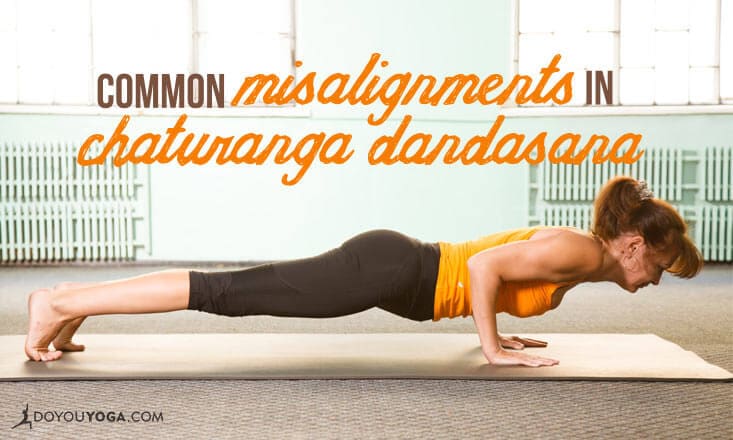Chaturanga Dandasana is one of the most common poses in a typical Vinyasa yoga class, but it's also one of the easiest to be misaligned in.
A misaligned Chaturanga can lead to painful wrists, sore back, and achy shoulders. Here are a few of the most common misalignments in Chaturanga Dandasana, and what to do about them!
1. Crooked Hands
Your middle finger should be pointed forward in Chaturanga to help your wrists not ache. The compression of the wrists in Chaturanga is off-set by the subsequent Down Dog, which should stretch the wrists enough to negate the achiness.
However if the hands are not straight in Chaturanga, then you run the risk of tweaking the wrist in an odd direction and then the stretch won’t work to rinse out the carpal tunnel.
So… middle finger points directly forward in Chaturanga and the rest of the fingers can be splayed out neatly alongside.
2. Elbows Not Stacking Over Wrists
This destabilizes the shoulders and can create upper back and arm tweaks. It is common because you cannot see what your forearms are doing when you're in Chaturanga, and we usually don’t hold the pose long enough to hear our bodies tell us we are misaligned.
To get this right you will need to practice lengthwise in front of a mirror a few times so you can memorize how it feels to be aligned.
Take Plank with your shoulders stacked over your wrists. Now lean your chest far forward until it peeks out over your fingers. You should be able to feel a deep warming compression in your wrists. Start to lower down half way.
Check the mirror; your upper arms should become more and more parallel to the ground and your elbows should line up directly over your wrists.
3. Hips Sinking to the Ground
If your hips touch the floor before anything else when you lower down from Chaturanga (or Plank) to the floor, then this is you. You are creating a wonderful beach hammock out of your spine whenever you come to Chaturanga!
Unfortunately, this will result in back pain. The problem here is a dis-engaged core. You can think of this pose as your arms pushing the floor away, and your core lifting you up. With those two actions happening, you hover lightly. Simply pull your belly in and try to bring your body down to the floor in one piece, with your belly lifting up and your arms pushing down.
If this is a challenge, bring your knees to the mat and be patient — your body will strengthen as you come to your mat regularly. Test it out every practice and spend a little extra time holding Plank Pose wherever you can.
4. Elbows Poking Out
This is the difference between a military push up and a yoga push up.
For your Chaturanga to be strong, you need to squeeze your elbows into your ribs and activate your triceps. If your elbows are splayed out to the side, you are activating your pectoral muscles instead of your upper arms and shoulders.
Lifting a heavy object with your elbows poking out to the side like that is very challenging.
To adequately lift, you need to keep those elbows tucked neatly in and lift from your central line.
What are some of the misalignments you've found in Chaturanga Dandasana? How have you fixed them? Share with us in the comments below!


